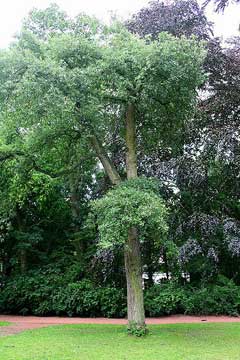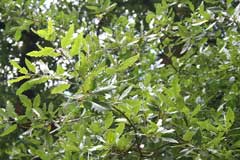 |
|
http://commons.wikimedia.org/wiki/User:Jean-Pol_GRANDMONT |
 |
| http://commons.wikimedia.org/wiki/User:Jean-Pol_GRANDMONT |
Translate this page:
Summary
Physical Characteristics

 Quercus hispanica is a deciduous Tree growing to 20 m (65ft) by 13 m (42ft).
Quercus hispanica is a deciduous Tree growing to 20 m (65ft) by 13 m (42ft).
See above for USDA hardiness. It is hardy to UK zone 7. The species is monoecious (individual flowers are either male or female, but both sexes can be found on the same plant) and is pollinated by Wind.
Suitable for: medium (loamy) and heavy (clay) soils and can grow in heavy clay soil. Suitable pH: mildly acid, neutral and basic (mildly alkaline) soils. It can grow in semi-shade (light woodland) or no shade. It prefers moist soil. The plant can tolerates strong winds but not maritime exposure.
UK Hardiness Map
US Hardiness Map
Synonyms
Plant Habitats
Woodland Garden Canopy;
Edible Uses
Edible Parts: Seed
Edible Uses:
Seed - cooked. Up to 2.5cm long. It can be dried, ground into a powder and used as a thickening in stews etc or mixed with cereals for making bread. The seed contains bitter tannins, these can be leached out by thoroughly washing the seed in running water though many minerals will also be lost. Either the whole seed can be used or the seed can be dried and ground it into a powder. It can take several days or even weeks to properly leach whole seeds, one method was to wrap them in a cloth bag and place them in a stream. Leaching the powder is quicker. A simple taste test can tell when the tannin has been leached. The traditional method of preparing the seed was to bury it in boggy ground overwinter. The germinating seed was dug up in the spring when it would have lost most of its astringency. The roasted seed is a coffee substitute.
References More on Edible Uses
Medicinal Uses
Plants For A Future can not take any responsibility for any adverse effects from the use of plants. Always seek advice from a professional before using a plant medicinally.
Astringent Dysentery
Any galls produced on the tree are strongly astringent and can be used in the treatment of haemorrhages, chronic diarrhoea, dysentery etc[4].
References More on Medicinal Uses
The Bookshop: Edible Plant Books
Our Latest books on Perennial Plants For Food Forests and Permaculture Gardens in paperback or digital formats.

Edible Tropical Plants
Food Forest Plants for Hotter Conditions: 250+ Plants For Tropical Food Forests & Permaculture Gardens.
More

Edible Temperate Plants
Plants for Your Food Forest: 500 Plants for Temperate Food Forests & Permaculture Gardens.
More

More Books
PFAF have eight books available in paperback and digital formats. Browse the shop for more information.
Shop Now
Other Uses
Cork Repellent Tannin Wood
The bark is a source of cork, it can be used for heat and sound insulation, flooring, floats etc. The bark is harvested every 6 - 12 years, being carefully removed so as not to harm the tree. A mulch of the leaves repels slugs, grubs etc, though fresh leaves should not be used as these can inhibit plant growth. Oak galls are excrescences that are sometimes produced in great numbers on the tree and are caused by the activity of the larvae of different insects. The insects live inside these galls, obtaining their nutrient therein. When the insect pupates and leaves, the gall can be used as a rich source of tannin, that can also be used as a dyestuff[4]. Wood -
Special Uses
References More on Other Uses
Cultivation details
Prefers a good deep fertile loam which can be on the stiff side[1, 11]. Young plants tolerate reasonable levels of side shade[200]. Tolerates moderate exposure, surviving well but being somewhat stunted[200]. Intolerant of root disturbance, trees should be planted in their permanent positions whilst young[11]. Grows fairly well in Britain, because of its hybrid parentage between the cork oak and the Turkey oak this tree is potentially a good source of cork for Britain. There are a number of named forms. 'Diversifolia' has a bark that is more corky than the type[11]. Hybridizes freely with other members of the genus[200]. Plants in this genus are notably resistant to honey fungus[200].
References Carbon Farming Information and Carbon Sequestration Information
Temperature Converter
Type a value in the Celsius field to convert the value to Fahrenheit:
Fahrenheit:
The PFAF Bookshop
Plants For A Future have a number of books available in paperback and digital form. Book titles include Edible Plants, Edible Perennials, Edible Trees,Edible Shrubs, Woodland Gardening, and Temperate Food Forest Plants. Our new book is Food Forest Plants For Hotter Conditions (Tropical and Sub-Tropical).
Shop Now
Plant Propagation
Seed - it quickly loses viability if it is allowed to dry out. It can be stored moist and cool overwinter but is best sown as soon as it is ripe in an outdoor seed bed, though it must be protected from mice, squirrels etc. Small quantities of seed can be sown in deep pots in a cold frame. Plants produce a deep taproot and need to be planted out into their permanent positions as soon as possible, in fact seed sown in situ will produce the best trees[11]. Trees should not be left in a nursery bed for more than 2 growing seasons without being moved or they will transplant very badly. This is a cultivar and it will not breed true from seed.
Other Names
If available other names are mentioned here
Native Range
EUROPE: Former Yugoslavia, Italy (incl. Sicily), France
Weed Potential
Right plant wrong place. We are currently updating this section.
Please note that a plant may be invasive in one area but may not in your area so it’s worth checking.
Conservation Status
IUCN Red List of Threatened Plants Status :

| Related Plants
|
| Latin Name | Common Name | Habit | Height | Hardiness | Growth | Soil | Shade | Moisture | Edible | Medicinal | Other |
| Quercus × schuettei | Schuette's oak | Tree | 18.0 |
4-8
| F | MH | N | MWe | 3 | 0 | 3 |
| Quercus acuta | Japanese Evergreen Oak | Tree | 25.0 |
6-9
| M | MH | SN | M | 2 | 2 | 2 |
| Quercus acutissima | Sawthorn Oak | Tree | 5.0 |
5-9
| M | MH | SN | M | 2 | 2 | 3 |
| Quercus agrifolia | Encina, California live oak, Coast Live Oak | Tree | 15.0 |
8-11
| S | MH | SN | M | 3 | 2 | 2 |
| Quercus alba | White Oak, Hybrid oak | Tree | 20.0 |
3-9
| S | MH | SN | DM | 3 | 2 | 4 |
| Quercus aliena | Oriental White Oak | Tree | 20.0 |
4-8
| | MH | SN | M | 2 | 2 | 2 |
| Quercus aucheri | Boz-Pirnal Oak | Shrub | 5.0 |
7-10
| S | MH | SN | DM | 4 | 2 | 1 |
| Quercus bicolor | Swamp White Oak | Tree | 25.0 |
4-8
| M | MH | SN | MWe | 4 | 2 | 3 |
| Quercus brantii | Barro, Brant's oak | Tree | 8.0 |
7-9
| F | LMH | N | DM | 3 | 2 | 3 |
| Quercus cerris | Turkey Oak, European turkey oak | Tree | 35.0 |
5-9
| F | MH | SN | M | 3 | 2 | 2 |
| Quercus chrysolepis | Live Oak, Canyon live oak | Tree | 25.0 |
8-11
| S | MH | SN | M | 2 | 2 | 2 |
| Quercus coccifera | Kermes Oak | Shrub | 4.0 |
5-9
| | MH | SN | M | 3 | 2 | 3 |
| Quercus coccinea | Scarlet Oak | Tree | 25.0 |
4-8
| M | MH | SN | M | 2 | 2 | 3 |
| Quercus dentata | Japanese Emperor Oak, Daimyo oak | Tree | 20.0 |
4-8
| F | MH | SN | M | 2 | 2 | 2 |
| Quercus douglasii | Blue Oak | Tree | 12.0 |
8-11
| S | MH | SN | DM | 3 | 2 | 4 |
| Quercus durata | California Scrub Oak, Leather oak | Shrub | 4.0 |
7-10
| | MH | SN | M | 2 | 2 | 2 |
| Quercus ellipsoidalis | Northern Pin Oak | Tree | 20.0 |
4-6
| M | MH | SN | M | 2 | 2 | 3 |
| Quercus emoryi | Black Oak, Emory oak | Tree | 12.0 |
6-9
| S | MH | SN | M | 3 | 2 | 3 |
| Quercus engelmannii | Evergreen Oak, Engelmann oak, Mesa Oak | Tree | 10.0 |
8-11
| M | MH | SN | M | 2 | 2 | 3 |
| Quercus falcata | Southern Red Oak, Cherrybark Oak, Spanish Oak, Southern Red Oak | Tree | 25.0 |
7-9
| M | MH | SN | M | 1 | 2 | 2 |
| Quercus floribunda | | Tree | 0.0 |
-
| | MH | SN | M | 2 | 2 | 3 |
| Quercus frainetto | Hungarian Oak, Italian Oak, Forest Green Oak | Tree | 30.0 |
5-8
| F | MH | SN | M | 4 | 2 | 2 |
| Quercus fruticosa | Gall Oak, Lusitanian Oak | Shrub | 2.0 |
7-10
| | MH | N | M | 3 | 2 | 2 |
| Quercus gambelii | Shin Oak, Gambel oak, Rocky Mountain White Oak | Shrub | 4.5 |
4-8
| S | MH | SN | DM | 3 | 2 | 3 |
| Quercus garryana | Oregon White Oak, Garry Oak | Tree | 18.0 |
7-9
| S | MH | SN | M | 2 | 2 | 3 |
| Quercus glauca | Ring-cup oak , Ring Cupped Oak, Blue Japanese Oak | Tree | 15.0 |
8-9
| S | MH | SN | M | 3 | 2 | 3 |
| Quercus ilex | Holly Oak, Evergreen Oak | Tree | 25.0 |
7-10
| S | LMH | SN | M | 5 | 2 | 3 |
| Quercus ilex ballota | Holm Oak | Tree | 25.0 |
6-9
| S | LMH | SN | M | 5 | 2 | 3 |
| Quercus imbricaria | Shingle Oak, Northern Laurel Oak | Tree | 20.0 |
4-8
| M | MH | SN | M | 2 | 2 | 3 |
|
|
Growth: S = slow M = medium F = fast. Soil: L = light (sandy) M = medium H = heavy (clay). pH: A = acid N = neutral B = basic (alkaline). Shade: F = full shade S = semi-shade N = no shade. Moisture: D = dry M = Moist We = wet Wa = water.
Expert comment
Author
Lam.
Botanical References
Links / References
For a list of references used on this page please go here
Readers comment
© 2010, Plants For A Future. Plants For A Future is a charitable company limited by guarantee, registered in England and Wales. Charity No. 1057719, Company No. 3204567.